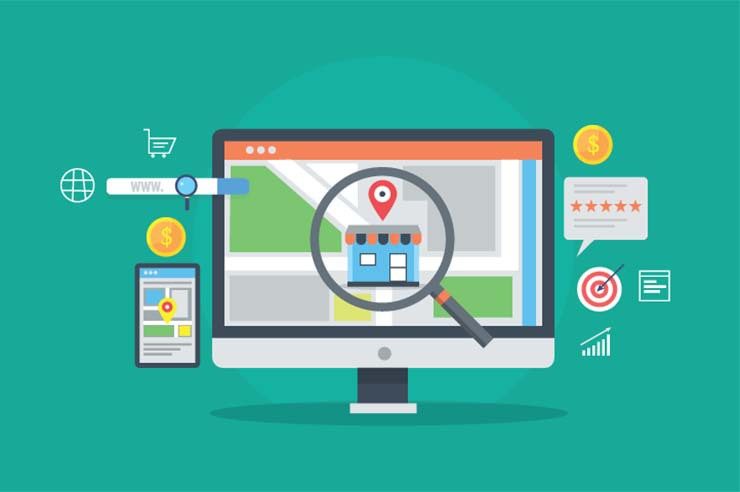The unknown of search results and local listings can be intimidating. When people are deciding where to spend their hard-earned money, they want to know they can trust the product, service, and reputation of your business. Customers want to rest assured that you’ll stand by what you sell, and this builds loyalty and trust. That’s why you’ll want a local SEO checklist to keep you on track.
As a business owner, you’re certain to have a full plate of responsibilities, and local SEO may not be at the top of your list. To grow the business and beat the competition, your online presence needs to be authentic, dynamic, user-friendly, and most importantly – effective.
The online space presents your business “face” to the world, but your local presence shouldn’t be left to linger in the dust as nearby individuals could be your best customers. This local SEO checklist covers some of the most important local SEO tactics to help your site be found in your city, county, and even region with improved organic rankings.
Off-Site Local SEO
Claim your Google My Business page
Google My Business (GMB) makes it easy to manage your business profile so you can stand out and bring customers in from Google Search and Maps. Claim your GMB profile, fill out the necessary information for your local SEO listing, and take advantage of features like:
- Update your profile anytime – make changes in a few easy steps and your listing will update across Search and Maps.
- Draw in customers with photos – add as many photos of your products and offerings as you like to show what’s unique about your business.
- Start a conversation – be the first to know when you get a new review on your local profile, so you can respond right away.
- Answer public questions – answer questions from customers from your profile to provide helpful information.
There are more categories to assign to your business than you can imagine, so choose the one that makes the most sense. Use localized keywords wherever you can as part of the submission process – according to Moz.com’s local search ranking factors, keywords, and categories in your GMB profile will account for about 25% of your chance of ranking in Google’s Local Pack.
What if I have more than one location? Claim each of your GMB listings and manage them all from one account login.
Use NAP citations
What’s NAP? This acronym stands for Name, Address, and Phone number, and you should ensure this information is correct and formatted consistently around the web. For example, if your business is located at 123 Main Street, don’t use “123 Main Street” in one place and “123 Main St.” in another. Be consistent.
Google and Yelp are two places people think about when it comes to finding local listings. Getting your NAP in these top citation sources is a good start, but it’s also important to consider other directories and niche markets such as:
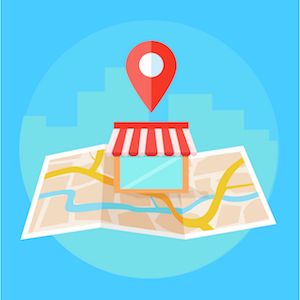
- Better Business Bureau
- Bing Local
- Business.com
- Chamber of Commerce
- CitySearch
- Foursquare
- Local.com
- Universal Business Listing
- Yahoo Local
- YellowPages.com
NAP on your website
Your NAP should be listed on every page of your website. A common practice is including your NAP in the footer (much like the way Oyova does), but it can also be listed above the navigation. A phone number at the very least is recommended in the navigation no matter where you decide to place the NAP.
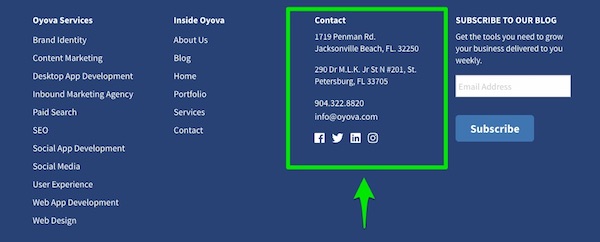
What if I have more than one location? Consolidating everything to one page isn’t great for local SEO, so if this is the case, create a page for each location and apply the respective NAP to that page, along with any other helpful information of course. And rather than stuffing addresses and phone numbers for all locations into your footer, go with your main or preferred location.
Build credible backlinks
Acquiring backlinks is like trying to get references for a job. When you get one, someone is saying, “I vouch for this person.” But just like job references, not all backlinks are worth the same. A link from a shady site won’t help your site rank.
Have a plan
First, think about your localized keywords and what you want to rank for. Then think about symbiotic industries that don’t compete directly with you but share a similar audience. For instance, a marketing agency that wants to work with small businesses may consider a small business lender. They share the same target market, but neither is a direct competitor.
Guest post
With your plan in mind, approach credible entities and bloggers and ask if they accept guest blog posts. If they do, find out what’s involved and have a couple of ideas ready to pitch in the event they won’t assign you one. Ask if you’ll get a byline or a backlink to your site – if the answer is no, move on. If they’ll provide a backlink, get started.
Not only is a link to your site helpful from a local SEO perspective, but you might also increase your reach and be shared on social media, which also helps with SEO. Don’t forget your blogging manners if you want to be invited back to post again.
Join your Chamber of Commerce
If you’re not a member of your Chamber of Commerce, ask what online exposure businesses receive. Some chambers have online directories, while others have guest blog opportunities, sponsorships, or other ways to receive a backlink.
Chambers generally rank well locally and get quite a bit of web traffic. If you’re already a member, make sure they have all your correct information and build out any profile opportunities you may have with them.
Get reviews for your online marketing strategy
Do you have a program in place for handling customer reviews? People are communicating and making purchase decisions online around the clock. Reviews of your business – positive or negative – have an impact on the way your customers behave, and this behavior inevitably affects your bottom line.
Leverage reviews for a good reputation
Think about the last few searches you made when hunting for a restaurant or local shop. Chances are you looked at reviews of the establishments. Whether it’s your own site, a social media channel, or an external source, don’t you want to interact with customers? Either side of the spectrum – good or bad – can yield a significant effect on sales and your overall reputation.
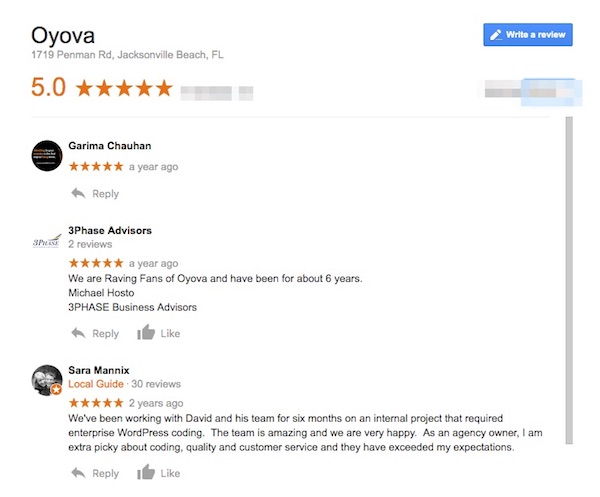
Respond to reviews – especially the bad ones
Engage with reviews (on Google, Yelp, Facebook, etc.) as soon as possible as the time has passed when business owners can ignore bad reviews. With 24-hour social media, you can no longer sweep reviews under the rug.
Address complaints with honesty, transparency, and do your best to resolve the problem swiftly if there is an ongoing issue. Address positive reviews with thanks and sincerity.
How do you get good reviews?
On your own website, have a dedicated and prominent place for reviews. Make it easy for visitors to find. Create a system to prompt reviews after a purchase. Some retailers list their websites on receipts and present customers with the opportunity to rate and review their service.
On exterior sites, make sure you have a presence and claim your business pages as soon as possible. If you’re a services company, register with Angie’s List. Get BBB accredited. If you own a restaurant, register it with OpenTable. If your industry has a specific site or app where business partners and customers can find you, be active and pay attention. Above all, place emphasis on quality products, services, and full-cycle customer relations.
Local SEO on Social
Connect with your local audience
Social media and SEO are intricately intertwined, and we cover this in our local SEO checklist. SEO and social media can work together, if done right, to help your local audience find the products and services they’re searching for online. If you’re doing one but not the other, you’re missing out on opportunities to connect with your customers and boost sales.
If you’re interested in effectively using social media and SEO to improve your local presence, understand that it takes strategic thinking, creativity, and a keen understanding of your brand.
Maintain social media business pages
Don’t have a Facebook page for your business yet? It’s time to create one, as social media signals pointing to your location and website is a ranking factor for local SEO. Other social profiles to consider managings are Twitter and Instagram, all of which are free and easy to set up.
Brand awareness on social media is necessary for business development, but not everyone realizes the correlation to local SEO. It’s this vast chain of cause and effect that brings it all together. Keep in mind, though, that quality matters, which means posting anything and everything for the sake of posting likely won’t help your search engine authority. Be smart, consistent, and stay true to your brand.
For SEO purposes, you don’t need to become an influencer. Maintain a simple social media strategy relevant to your business for any locations you have and include NAP citations and links to your website in all profiles.
Create posts specifically for local audiences
Using social media for local SEO can also have a substantial impact on your local audiences and can reach untapped customers. Take advantage of every opportunity where you attend or host a local event, start a sale, and other things worth sharing. Broadcast widely on social media ahead of time using posts not only with localized keywords but with detailed information too. It’s likely that at some point you’ve been interested in an event but couldn’t find an address or phone number, so think of the customer.
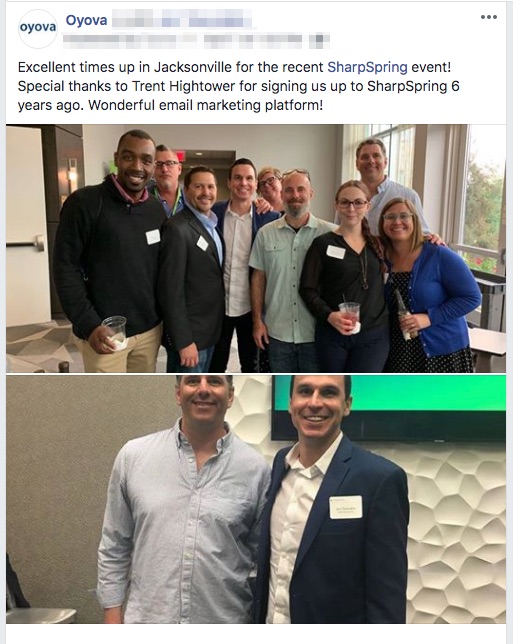
It will take some research, but if you can also find your most vocal local supporters and engage with them and share their social media posts, your visibility in local searches will increase too.
Furthermore, your social posts should include relevant keywords and phrases, but don’t overwhelm followers with stuffed keywords – people are perceptive and will be turned off if they aren’t getting enough value for their time.
Remember that social media platforms are search engines
Since most people are on social media for entertainment and connecting with friends, family, and like minds, you can’t treat it like you would Google. Content always composed to sell, sell, sell, won’t work. But, you can keep social media and local SEO connected with fantastic imagery, language, humor, and emotion.
Did you know that YouTube is the second most-searched search engine? According to BusinessInsider.com, YouTube is pulling in over 1.8 billion users every month. If you don’t currently have a YouTube channel, then it’s time to consider it. Being creative here, as well as with other social media platforms, can help to advance your local SEO game, broaden your audience, and stimulate sales.
Local SEO on Your Website – Local SEO Checklist
Emphasize hyperlocal marketing
Hyperlocal marketing – a form of niche marketing that targets consumers in a specific city (bicycle repair in Jacksonville, for example) – has begun to take off as a way to target customers near one’s local business. Granted, before the Internet and mediums like television and radio, it was the only way to market one’s business. However, businesses now have the technology to closely analyze their local market and target certain individuals, rather than shouting from their storefronts in the hope of enticing customers to visit their stores.
As mobile usage continues to increase, and virtual reality becomes more mainstream, businesses will need to place more emphasis on local SEO by focusing on hyperlocal keywords and catering to the nearly instantaneous needs of those who are close by.
Google has played an important part in this trend by reducing the number of pages available in their map search results. And perhaps more importantly, Google continues to see an increase in “near me” and “nearby” searches, which they refer to as “I-Want-to-Go moments.” In turn, businesses need to place importance on optimizing for both local and mobile as 94% of people in the United States with smartphones search for local information on their phones.
Know your local audience
Before you can speak the language of your audience, you must get to know them. Potential local customers already have an idea of what they’re searching for, which means it’s up to you to convince them to choose you. Ask yourself questions about your customers such as:
- How old are they?
- Where are they located?
- What’s their gender?
- Where do they hang out online?
- What are their interests?
Most customers don’t respond well to direct sales. Instead, they’re more interested in information that pertains to their needs. They could be looking for store hours, reviews, or perhaps local SEO services to improve their own search presence.
Create content: Localized SEO content is king
When writing localized marketing copy, it’s important to inform and educate your audience to help them make better buying decisions. Content on your site should speak to their needs and questions, and this will help you gain their trust. It must be engaging, relevant, well-written, and easy to digest. If you can tick off these characteristics, visitors will be more likely to convert because they’ll be pleased with their experience.

Incorporate relevant, localized keywords into your content. If you own a bicycle repair shop in Jacksonville, for instance, you’ll want to optimize your site with keywords like:
- Jacksonville bicycle repair,
- Bicycle shop in Jacksonville,
- Where to fix a bicycle, and
- Other localized, niche variations
Keep in mind, however, that keyword stuffing is a bad idea. Search engines can sniff out unnatural keyword usage, and visitors could be distracted by the wording or overuse of keywords, ultimately causing them to go elsewhere. Keep visitors engaged by executing natural keyword placement with grace.
Remember to include helpful outbound links that can enhance your content. Link externally to trusted sources and partners, and there’s a chance those sites may link back to you. As your reach and brand recognition increase, so will your reputation and visibility in local search results.
Take mobile-first indexing to heart for local SEO
Chances are, most of your customers are coming from Google, so following their search engine marketing guidelines is imperative.

And per Google, mobile-first indexing means they’ll “predominantly use the mobile version of the content for indexing and ranking.” Until recently, Google’s index used the desktop version of a page’s content when evaluating its relevance to the user’s search query. With so many people searching on their smartphones (and in a localized manner to boot), it makes sense now that Google’s index will primarily use the mobile version of a page’s content going forward.
The desktop site version of your business might be difficult to use on a mobile device. There’s obviously less room on a phone’s screen than on a computer’s, so you must focus on what’s most important when conveying visuals to your visitors. Have you ever had to pinch with your fingers to zoom in to see stuff? Or can’t easily click links and buttons? Users find this to be a frustrating experience and will probably abandon your site, and to make matters worse, go to a competitor. A mobile-friendly site should be readable and usable for smartphones. Take Google’s free test to see how easily visitors can use your site on their mobile devices.
Make your site user-friendly
People are impatient. They’re demanding more and more each day from their experience on the web, especially when searching for information about local shops and restaurants. If your website is not user-friendly then your business will suffer. It only takes a few seconds to lose the attention of a viewer.
Common problems that companies face with local SEO unfriendliness can include:
- Slow page loading (often due to large images and older designs)
- Poor responsiveness for mobile devices
- Confusing design of pages
Help your customers get what they need. If you own a restaurant, local searchers may want to get your business address or look at the menu. If you repair bicycles, they could be interested in reading customer reviews or looking at photos of your repair shop. So, design your site to help make it easier for customers to find what they need.
Remember that you don’t have to sacrifice aesthetics if you build a responsive website. Outside of maximizing the impact of your content, effective local SEO practices involve redesigning the website to bring it up-to-date with our fast-paced and increasingly on-the-go society. If your website displays in an odd or difficult-to-maneuver way on smartphones, that can cause a deep dive in your conversion rates.
Improve Your SEO Presence With a Local SEO Checklist
Having a local SEO strategy and creating a full cycle of care for your customers is necessary for a truly effective online marketing strategy and an authoritative local presence. Represent your brand in the best light before, during, and after purchase, and give your customers plenty of opportunities to pat you on the back.
A local SEO agency and social media team can help your online business in many ways, helping you to achieve and exceed your business goals through quality, targeted content, and customized strategies for success. Use our Local SEO checklist as a guide in the meantime.
A dedicated partner like Oyova is important to have for many reasons, but they can also help to keep your customers active and motivated to talk about your products and services online.

